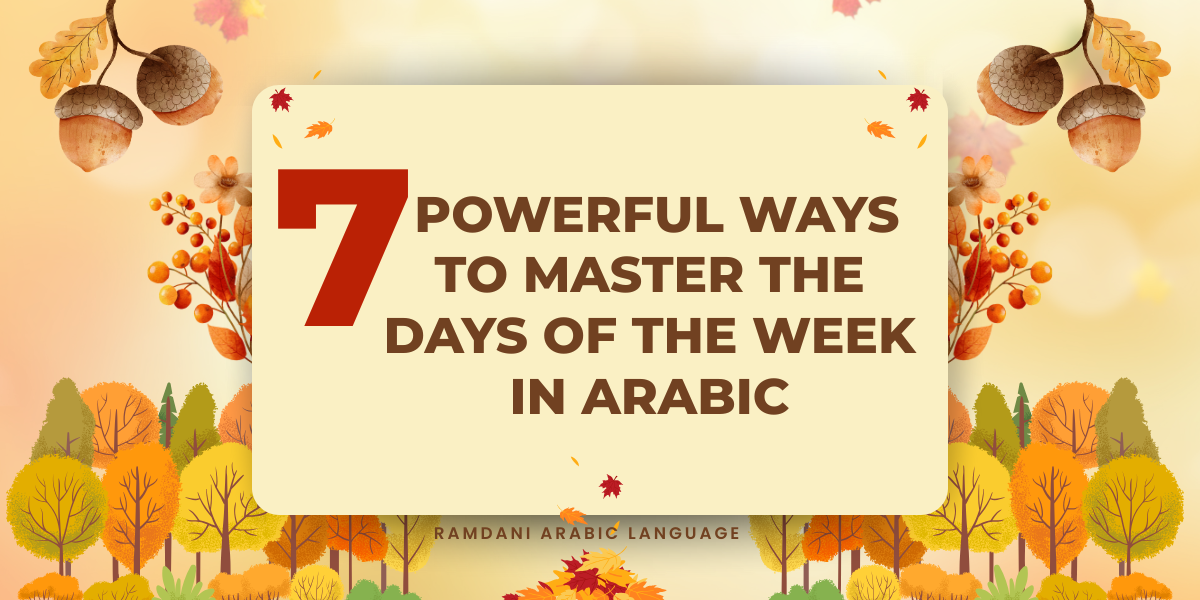7 Powerful Ways to Master the Days of the Week in Arabic
Learning a new language is more than memorizing vocabulary or grammar rules. It is about understanding the culture, traditions, and daily life of the people who speak it. For Arabic learners, this includes not only mastering the alphabet and pronunciation but also grasping concepts that shape everyday life, such as the days of the week. Knowing the days is essential. It allows you to plan activities, attend classes, understand schedules, and communicate effectively with native speakers. Each day carries not only a name but also historical, religious, and cultural significance in the Arab world.
The Arabic language has its own structure for days, which differs from English in some ways but also reflects logical patterns that make it easier to learn. The names of the days are not random. They are often connected to numbers, celestial bodies, or historical and religious traditions. Understanding these connections gives learners insight into the Arab worldview and the way time is perceived and valued. For someone studying Arabic, recognizing these patterns helps in remembering vocabulary naturally, without relying solely on rote memorization.
In addition to practical use, the days of the week provide a window into Arabic-speaking cultures. They affect daily routines, business hours, and social life. For example, the weekend in many Arab countries differs from Western countries, with Friday holding particular importance as a day of prayer and gathering. Knowing which day is considered the start of the week or the day for communal activities helps learners navigate conversations and social expectations more confidently. This cultural awareness makes language learning richer and more meaningful.
At Ramdani Arabic Academy, we focus not only on teaching words but on helping learners understand how to live the language. We integrate lessons about daily life, traditions, and cultural nuances alongside grammar and vocabulary. By studying the days of the week, students gain skills that go beyond language—they gain the ability to connect with Arabic speakers, participate in cultural activities, and structure their daily routines in Arabic. This holistic approach ensures that learning Arabic is not just academic but practical and engaging.
This article will guide you through the names, meanings, and cultural significance of each day of the week in Arabic. You will discover patterns that simplify learning, historical references that deepen understanding, and tips for remembering the sequence of days. By the end of the article, you will not only be able to use the days of the week confidently but also appreciate their role in Arab culture and daily life.

The Days of the Week in Arabic
Learning the days of the week in Arabic requires more than memorization. Each day has a name, a meaning, and a cultural context that makes it easier to remember and use. Arabic days are closely linked to numbers and traditional concepts, which helps learners understand them logically.
Sunday – الأحد (Al-Ahad)
Al-Ahad literally means “the first.” In Arabic culture, Sunday is considered the first day of the week. Unlike in many Western countries where Sunday is often seen as a day of rest, in most Arab countries, it is a working day. Schools, offices, and businesses open on Sunday, making it the start of the weekly routine.
- Practical tip: Remember “Ahad” by associating it with “one” or “first.”
- Cultural note: Sundays are normal working days, so scheduling meetings or classes on this day is common.
Monday – الإثنين (Al-Ithnayn)
Al-Ithnayn means “the second.” This day follows logically after Sunday and is part of the standard workweek. Many learners notice the numerical pattern in Arabic day names starting from Sunday, which makes memorization easier.
- Practical tip: Think of Al-Ithnayn as “two” to remember it as the second day.
- Cultural note: Monday is a regular working day. Many business activities pick up pace after the weekend, so you will hear phrases like “بعد الإجازة” (after the holiday) in conversations.
Tuesday – الثلاثاء (Ath-Thulatha)
Ath-Thulatha translates to “the third.” The Arabic naming system continues the numerical sequence.
- Practical tip: Associate “Thulatha” with “three.” This helps in ordering the days mentally.
- Cultural note: Tuesday is commonly a full workday. In school schedules, students often have major subjects planned on this day.
Wednesday – الأربعاء (Al-Arba’a)
Al-Arba’a means “the fourth.” The number four is easy to recognize and remember.
- Practical tip: Linking Al-Arba’a to “four” reinforces your memory.
- Cultural note: Wednesday is midweek. People often plan events or appointments as they approach the weekend.
Thursday – الخميس (Al-Khamis)
Al-Khamis translates to “the fifth.” By this day, the week starts slowing down, and anticipation of the weekend grows.
- Practical tip: “Khamis” sounds like “five,” which makes it easier to recall its order.
- Cultural note: In many Arab countries, Thursday marks the last working day before Friday, the traditional day of rest. Businesses may close earlier.
Friday – الجمعة (Al-Jum’a)
Al-Jum’a means “gathering.” Friday is unique in Arabic culture and Islamic tradition. It is the day of the weekly congregational prayer (Jumu’ah) and often a day off or half-day in many countries.
- Practical tip: Remember Jum’a as a special day, different from numbered days.
- Cultural note: Friday is central to religious and social life. Families gather for prayers and meals. Many cultural activities and markets are busier on this day.
Saturday – السبت (As-Sabt)
As-Sabt means “Sabbath,” a day of rest. In some Arab countries, Saturday is a working day; in others, it is part of the weekend alongside Friday.
- Practical tip: Link As-Sabt with “rest” to remember its cultural significance.
- Cultural note: Saturday varies depending on the country. In Gulf countries, it is often a weekend day. Learning the local schedule helps avoid confusion.

Using the Days of the Week in Daily Life
Knowing the days of the week in Arabic is only the first step. The next step is applying them in conversations, schedules, and everyday activities. This section will guide you through practical usage and tips that make learning easier and more natural.
Common Phrases with Days
Learning phrases helps you remember days in context. Here are examples you can practice:
- اليوم هو الاثنين (Al-Youm huwa Al-Ithnayn) – Today is Monday.
- غداً الثلاثاء (Ghadan Ath-Thulatha) – Tomorrow is Tuesday.
- أمس كان الأحد (Ams kan Al-Ahad) – Yesterday was Sunday.
- متى الصف؟ يوم الأربعاء (Mata As-Saff? Yawm Al-Arba’a) – When is the class? Wednesday.
- الاجتماع يوم الجمعة (Al-Ijtimaa’ Yawm Al-Jum’a) – The meeting is on Friday.
Practicing these sentences helps learners connect day names with real-life situations. Using “today,” “tomorrow,” and “yesterday” is common in conversation and helps anchor the days in memory.
Remembering the Days
Arabic day names follow a pattern for the first five days: they are numbered.
- الأحد (Al-Ahad) – first
- الإثنين (Al-Ithnayn) – second
- الثلاثاء (Ath-Thulatha) – third
- الأربعاء (Al-Arba’a) – fourth
- الخميس (Al-Khamis) – fifth
This numerical pattern makes it easier to recall the sequence. The last two days, Friday (Al-Jum’a) and Saturday (As-Sabt), are culturally significant rather than numbered, which makes them stand out in memory.
Tips to remember:
- Create a weekly routine in Arabic. For example, plan your week using the Arabic names.
- Use flashcards with the day on one side and the number or meaning on the other.
- Practice writing sentences like “I have a lesson on Wednesday” or “The weekend is Friday and Saturday.”
- Link days to real events, like prayers, holidays, or classes. Associating words with experiences helps retention.
Practical Usage in Conversations
Understanding the days is vital in daily interactions. Here are examples:
- Making plans:
- “هل نلتقي يوم الخميس؟” (Hal naltaqi yawm Al-Khamis?) – Shall we meet on Thursday?
- “هل نلتقي يوم الخميس؟” (Hal naltaqi yawm Al-Khamis?) – Shall we meet on Thursday?
- Scheduling appointments:
- “الزيارة يوم السبت” (Az-Ziyara Yawm As-Sabt) – The visit is on Saturday.
- “الزيارة يوم السبت” (Az-Ziyara Yawm As-Sabt) – The visit is on Saturday.
- Discussing routines:
- “أدرس العربية كل يوم الاثنين والأربعاء” (Adrusu Al-Arabiya Kull Yawm Al-Ithnayn wal-Arba’a) – I study Arabic every Monday and Wednesday.
- “أدرس العربية كل يوم الاثنين والأربعاء” (Adrusu Al-Arabiya Kull Yawm Al-Ithnayn wal-Arba’a) – I study Arabic every Monday and Wednesday.
Using days in conversation also improves understanding of calendars, emails, and schedules in Arabic.
Cultural Notes
Some days have cultural or religious significance.
- Friday is a prayer day and often a day off.
- Saturday may or may not be part of the weekend depending on the country.
- Recognizing these differences helps learners avoid mistakes and communicate appropriately.
Practice Ideas
- Keep a small Arabic calendar and write activities in Arabic.
- Label days of the week on your planner in Arabic.
- Say the day aloud every morning to reinforce pronunciation and memory.
- Pair days with numbers for quick recall: Sunday-first, Monday-second, etc.
By integrating days into daily practice, learners internalize both the vocabulary and the cultural context. Over time, using Arabic to talk about time and schedules becomes natural.

History and Cultural Significance of the Days
Understanding the days of the week in Arabic is more than memorizing names. Each day carries historical and cultural meaning that reflects Arab traditions, religion, and daily life. Knowing these details helps learners appreciate the language and remember vocabulary naturally.
Sunday – الأحد (Al-Ahad)
Al-Ahad, meaning “the first,” reflects the start of the week. Historically, Arabic-speaking communities followed lunar calendars, and Sunday was the first working day after the weekend.
- Cultural note: Sunday is a typical workday in most Arab countries. Knowing this helps learners understand local schedules.
- Tip: Think of Sunday as the first step in your weekly routine. Associating it with the start of new activities reinforces memory.
Monday – الإثنين (Al-Ithnayn)
Al-Ithnayn means “the second.” Early Arab scholars and communities used numbers to name days for clarity and organization. This method is practical and easy to learn.
- Cultural note: Monday is often a busy day for work and school. People resume tasks after the weekend.
- Tip: Pair Monday with “second” in your mind. Visualizing a sequence of numbers strengthens recall.
Tuesday – الثلاثاء (Ath-Thulatha)
Ath-Thulatha, meaning “the third,” follows the numerical pattern. Its name reminds learners of order and structure in Arabic.
- Cultural note: Tuesday often carries no special cultural events but is important for school and work planning.
- Tip: Use a weekly schedule in Arabic to practice linking the day with activities.
Wednesday – الأربعاء (Al-Arba’a)
Al-Arba’a translates to “the fourth.” In historical contexts, midweek was significant for trade and community planning in Arab towns.
- Cultural note: Midweek events, appointments, and market days often fall on Wednesday in traditional settings.
- Tip: Connect Wednesday with midweek tasks. This creates a mental anchor for remembering its position.
Thursday – الخميس (Al-Khamis)
Al-Khamis means “the fifth.” Historically, Thursday was often a day to prepare for Friday gatherings and prayers.
- Cultural note: Many businesses close early on Thursday in preparation for Friday.
- Tip: Link Thursday with preparation and planning. Associating it with upcoming events makes it memorable.
Friday – الجمعة (Al-Jum’a)
Al-Jum’a, meaning “gathering,” is deeply rooted in Islamic tradition. It is the day for the congregational Jumu’ah prayer, family gatherings, and social life.
- Cultural note: Friday is a public holiday in many Arab countries. Understanding its importance is essential for learners who want to participate in cultural and religious life.
- Tip: Remember Jum’a as a special day. Visualize communal activities and prayers to strengthen memory.
Saturday – السبت (As-Sabt)
As-Sabt, meaning “Sabbath,” has biblical and historical roots. It represents rest and reflection. In some Arab countries, it is part of the weekend; in others, it is a working day.
- Cultural note: Saturday may vary in significance depending on local practices.
- Tip: Use Saturday as a flexible point in your schedule. Associating it with rest helps retain its cultural meaning.
Learning Tips for Cultural Context
- Connect each day with its meaning or number in Arabic.
- Observe daily life in Arabic-speaking communities, noticing how weekdays and weekends are structured.
- Practice using day names in context: schedule appointments, talk about past and future events, or describe routines.
- Combine linguistic practice with cultural understanding to reinforce both memory and practical use.
By learning the history and cultural significance, you do more than memorize words. You understand how time is experienced and organized in Arabic-speaking societies. This approach strengthens language retention and makes your learning relevant to real life.
Final word
Learning the days of the week in Arabic is a foundational step for anyone studying the language. It goes beyond memorizing names. It connects you to daily life, cultural practices, and social routines in Arabic-speaking communities. By understanding the numerical pattern of the first five days and the special cultural significance of Friday and Saturday, you gain both practical skills and cultural awareness.
Using the days in conversation, scheduling activities, or planning weekly routines strengthens your language skills. Regular practice helps internalize pronunciation, vocabulary, and sentence structure. Associating days with numbers, events, and cultural practices makes remembering them easier. Writing schedules, speaking about your week, and observing local customs are effective ways to reinforce learning.
At Ramdani Arabic Academy, we focus on combining language learning with cultural understanding. Our courses and lessons are designed to give you tools that go beyond grammar and vocabulary. We provide practical exercises, real-life examples, and explanations of cultural nuances, helping learners communicate naturally and confidently in Arabic. Whether you are learning for travel, work, or personal growth, understanding the days of the week is a small but essential part of building fluency.
The author, Ramdani Mohamed, created this academy to make Arabic accessible to learners around the world. Through structured courses, detailed articles, and interactive lessons, the academy guides students step by step. Every article, including this one, is designed to teach both language and culture, so learners can use Arabic effectively in daily life.
As you continue your journey, practice using the days of the week in real contexts. Ask questions, plan your activities in Arabic, and observe how native speakers refer to time. Small daily habits, like saying the day aloud each morning or writing your schedule in Arabic, make a significant difference. Over time, these habits build fluency and deepen your understanding of Arabic culture.
Learning the days of the week is more than a lesson. It is a doorway to understanding Arabic life, thinking in Arabic, and connecting with speakers naturally. With consistent practice and cultural awareness, you will find that this knowledge becomes an intuitive part of your language skills.







